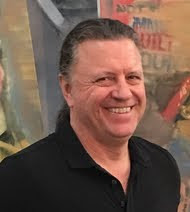Wunderkammer
 Lise Patt
Lise Patt"Traumbagger"
On Sunday, November 13, 2005, from 2-5 pm, a reception will be held at The Institute of Cultural Inquiry (ICI) at 1512 South Robertson Blvd in Los Angeles.
This special open house will borrow from the Renaissance “Wunderkammer” tradition—every usable surface of the Institute will be covered with projects created during the organization’s 15 year history.
 Ole Worm's Wunderkammer (Cabinet of Curiosities)
Ole Worm's Wunderkammer (Cabinet of Curiosities)Frontispiece from the 1655 catalog : "Worm's Museum, or the History of Very Rare Things, Natural and Artificial, Domestic and Exotic, Which Are Stored in the Author's House in Copenhagen."*
The Danish professor of medicine Ole Worm (1588-1654) believed that learning comes about through the observation of nature - "through empiricism and experiment" - and not just through the study of texts. Worm firmly believed that vision was the most trustworthy sense for investigations of our environment.
To explore these ideas, Ole Worm assembled a sort of museum or Wunderkammer (Cabinet of Curiosities) in his Copenhagen home. Filled with ethnographic specimens, skulls, stuffed animals, and the latest in optical and experimental devices, the early museum was both artwork and laboratory.
Many of the ICI projects on view during their "Wunderkammer" open house, focus on mechanisms of analysis that through time have become lost, forgotten or suppressed:
 Melinda Smith Altshuler "Self Portrait"
Melinda Smith Altshuler "Self Portrait"Melinda Smith Altshuler, an associate at the ICI, discovers and recreates, almost like an artistic crime scene investigator, personal histories found in discarded memorabilia and cast off items from daily life. We are drawn into her artwork as if into another world. And we ask questions. What is this amber material on which these images hover? Is it a sort of paper or skin? Who are these people peering out at us from the past? What are they trying to tell us? But unlike the television investigators on CSI, when Melinda finishes her examinations, more questions, not less, remain. Melinda Smith Altshuler's artworks provide beautiful clues to a past that is just out of reach and a future that we can almost, but not quite, grasp. Her profoundly poignant work investigates memory and also hope.

Another work that I am interested in exploring at the ICI is the forthcoming book: "Searching for Sebald": an investigation by Christel Dillbohner and Lise Patt of the late author and photographer, W.G. Sebald. W.G. Sebald's writings, prose and poetry, are open ended investigations into experience.
Christel Dillbohner and Lise Patt have found that many recent scholarly texts address Sebald's complex prose, "Searching for Sebald" will be the first to explore Sebald's fictive world by discussing the anti-heroic photographs that propel and interrupt his twisting narratives.
Like Lise Patt from The Institute of Cultural Inquiry, I have dreamt that Wim Wenders put me in a movie. It was a scene with Columbo (Peter Falk) and we were drawing together on a street that flickered back and forth from black and white to color. We didn't talk. And there was a wind whipping the pages of our sketchbooks as if the angel of history had just lifted off.
* (The artist Rosamond Purcell fashioned a meticulous re-creation of Ole Worm's collection in her exhibition "Rosamond Purcell: Two Rooms," organized by the Santa Monica Museum of Art and curator Lisa Melandri.)

0 Comments:
Post a Comment
<< Home